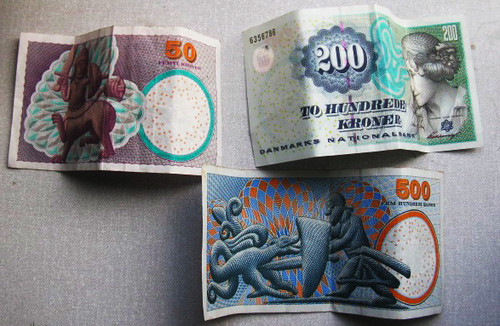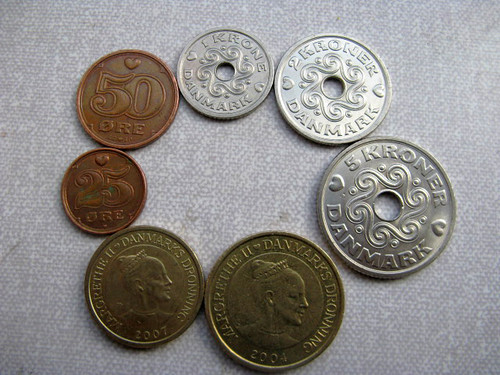Denmark’s currency is the Danish Crown, called Danske krone in Danish (abbreviated DKK). At the time of this writing, 1 USD is just under 6 DKK (~5.98). Last fall, 1 USD was about 5 DKK. So to get an approximate value of how much an item costs in USD, you’d divide the amount in kroner by 5. So 100 DKK is about $20 (actually it’s less than that since the exchange rate is about 5.98-ish, but I’d rather overestimate the value by a few dollars than underestimate it).
The plural form of “krone” is “kroner.” Krone is the Danish word for crown. When I first arrived last fall I kept saying “kroners” to make it plural but that’s a redundancy because “kroner” is already plural. Saying “kroners” is like saying “dollarses.”
Well, there are quite a few coins. Sometimes I still struggle to remember which is which. To alleviate that problem, I am going to sort all of my coins out and place them in separate bags according to value. I will then clearly label each bag (e.g. 5 DKK). The Danish coins are (clockwise, starting from the smallest silver coin at the top in the picture at left): 1-krone, a 2-kroner, 5-kroner, 20-kroner and 10-kroner. The 1, 2 and 5 kroner coins come with nifty little holes in the middle. I assume it’s so you can string them together and wear them as a necklace so you’ll always have change with you?
There are also 25- and 50 øre coins. 100 øre = 1 krone. So 50 øre is half a krone and 25 øre is a quarter-krone. But the 25 øre coins went out of commission in October 2008 and are no longer in use.
The Danish paper money is also quite interesting and colorful to boot. You can get a 50 kroner bill, 100, 200, 500 and 1000. According to Wikipedia they are going to redesign the bills between 2009 and 2012, with Danish bridges as the theme.
Note: The paper money pictured at the top is actually part of my rent money. I snapped a photo of it just before I took it down to the post office to pay my rent for the month. ;-)








